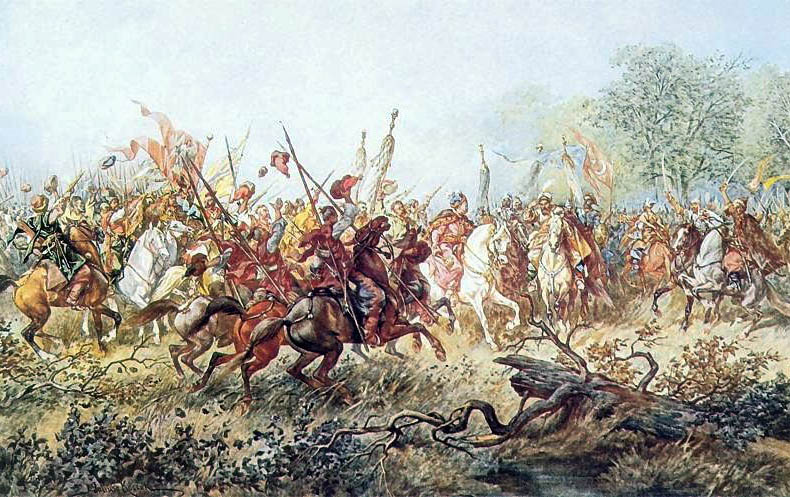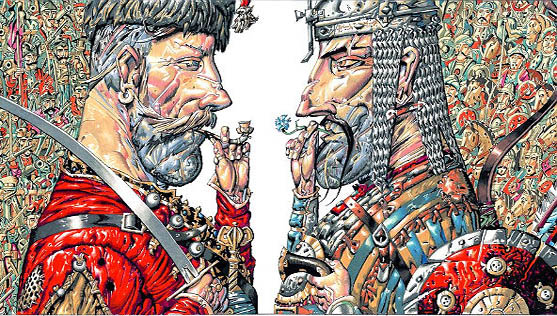The Cossacks and the Tatars. Artist Oleksandra Mikhnusheva //
https://www.istpravda.com.ua/articles/2011/03/15/31684/view_print/
The main objective for this stereotype to have been generated is to show the image of Russia as that of the incomparable strength capable of protecting the Ukrainians from the attacks of their “eternal enemies” – the Tatars and the Turks.
The relations between the Slavic Ukrainians who lived at the North Pontic (the southern region of Ukraine) and the Crimean inhabitants (the Tatars, the Turks, the Nogays) had never been easy for many centuries and been accompanied by disputes, attacks and wars. As the result, there emerged a stereotype on the constant confrontation between the Ukrainians, the Tatars and the Turks and that it had been lasting as long as from the 13th century (the Golden Horde establishment) up to the annexation of the Crimean khanate in the 18th century. Moreover, this stereotype was reinforced by the opinion of the European civilization of that time to see the opposing force in the Turkish nation.
The first documental recordings concerning of what was occurring on the Ukrainian lands tell us that here had always been confrontations between the rival worlds of the nomads and the landworkers, namely between the Scythians and the Sarmatians on the one side and the ancestors of the Slavic folks on the other one. The medieval Ruthenians, the inhabitants of Rus, had to counteract the offensives of the Pechenegs and the Cumans. This is explained by the fact that the Ukrainian lands were the part of so-called Great Steppe Border, where one could encounter the nomads and the landworkers, the Christians and the Muslims, the Slavic and the Turkic. It is obviously clear, that the interaction of such different civilisations and cultures caused their collisions and confrontations.
However, not only the word of confrontation describes the relations between the Slavic Ukrainians and the Turkic Tatars. One cannot ignore the well-known facts of the trading and cultural tights between the Rus and the Cuman nobilities. Take into account a considerable number of the ethnic Tatars within the Ukrainian Cossacks. Moreover, at the territory of Volyn(Volhynia), there was the Tatar enclave while, on the other hand, the various sources evidence that there were tens of the Cossacks’ winter dwellings (zymivnyk) within the lands of the North Pontic and the Crimea.
The Crimean khanate had never aimed at conquering Ukrainian lands but with their constant military expeditions, they tried to maintain the balance between Rzeczpospolita and the Moscovian tsardom. The Turkish took a little bit different strategy. The result of their expansion was not in absorbing the conquered lands but in establishing the states under their control, namely Wallachia, Transylvania, the Crimean khanate. Moreover, those states preserved their religious and cultural identity and even the political one to a certain degree.
For the Turkish, these states under their power in the North Pontic and in the Balkans were acting as a buffer zone to resist Austria, Rzeczpospolita, Muscovy (Moscovia).
The Turkish authorities expressed the positive attitude concerning the beginning of the Cossack-Polish War in 1648 since the military success of the Cossacks could facilitate Rzeczpospolita’s weakening. The Turkish sultan did not object that his vassal (the Crimean khan) was supporting the Cossack Host. It is well known that at the beginning of the war, it was Perekop Murza Toğay bey who became an ally of Bohdan Khmelnytsky and helped to defeat the Polish army in several battles. In the Chronicles (litopysy) of Samiilo Velychko, we read, “The Polish yoke of serfdom was chopped off and destroyed by the Cossacks’ and the Crimeans’ swords”.

In 1659, the Tatars helped Hetman Ivan Vyhovskyi to defeat the Muscovy army in the Battle of Konotop.
In 1669, the Turkish and the Tatars acted as allies for hetman Petro Doroshenko, whose efforts were directed for the sake of Hetmanate reunification after it had been partitioned between Poland and Muscovy by the provisions of the Truce of Andrusovo in 1667. Finally, it turned out that the Turkish proved to be undependable allies, however, the Turkish control over Podillia (Podillya, Podilia) and their protection over Hetmanate did not destroy the Ukrainian civilisation. Within the territories conquered by them, there were functioning the mosques along with the Christian Orthodox churches, Ukrainian schools were teaching the children. The particular Orthodox eparchy was installed in Kamianets in 1681. The Constitution of Pylyp Orlyk written in 1710 tells, “the laws of the nearest neighbourhood tighten inextricably and unite closely the destiny of the Cossack folk and the Crimea state.”
During the period of the Chortomlyk Sich (also Old Sich) and Pidpilnenska Sich (New Sich), the Cossacks were not only at war against the Tatars and the Turks, but established the trading relations with them. They were regularly negotiating and coming to the agreement concerning the hunting and fishing areas in the south of Ukraine.
After the Russian ruined these Siches (in 1709 and in 1775, respectively), the part of the Cossacks decided to accept the protection of the Ottoman sultan.
Certainly, to say that the Cossacks were absolutely satisfied with their status under the Turkish protection over them was not really a true, but it goes without saying that there was no deadly confrontation there.
Eventually, the Slavic and the Turkic civilisations were not antagonistic, though the militating confrontations were frequent. However, these confrontations were not much different from the conflict between England and France that lasted several hundred years or that between France and Germany. Instead, we can speak about them as about the interaction, time by time that became mutually advantageous, and had manifestations in the form of cultural interchange, trading, political and military alliances.
Our Advice to Read:
Брехуненко В.А. Війна за свідомість. Російські міфи про Україну та її минуле.‒ Київ, 2017.‒ 280 с.
Між конфронтацією та взаємодією: українсько-кримські та українсько-ногайські стосунки в XVІI – першій половині ХХ ст. / за ред. В.
Брехуненка.– Київ: ІУАД, 2018.– 344 с.
Стороженко І.С. Богдан Хмельницький і воєнне мистецтво у визвольній війні українського народу середини ХVІІ століття.– Дніпропетровськ: Вид-во Дніпропетр. держ. ун-ту, 1996.– Кн.1: Воєнні дії 1648–1652 рр.– 1996.– 320 с.: іл.











